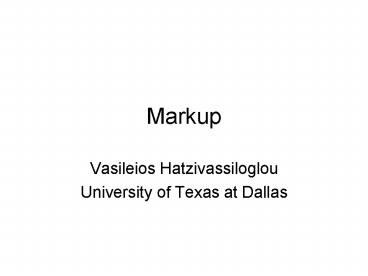Markup - PowerPoint PPT Presentation
1 / 22
Title:
Markup
Description:
Smoothing a model is the replacement of some ... Adverb, deictic. AVQ. WRB. WRB. when. Adverb, question. AVQ. WRB. WQL. how. Adv, question, intensifier ... – PowerPoint PPT presentation
Number of Views:395
Avg rating:3.0/5.0
Title: Markup
1
Markup
- Vasileios Hatzivassiloglou
- University of Texas at Dallas
2
Smoothing
- Smoothing a model is the replacement of some
probability estimates with other estimates
believed to be more reliable - Avoid estimating zero probabilities by always
assigning a non-zero (very small) probability to
all possible events - Additive smoothing Smooth by increasing observed
counts by a constant
3
Two kinds of smoothing
- Backoff smoothing Estimate using the probability
of a more general event that directly includes
the event in question - Class-based smoothing Estimate using the
probability of a class of events that is
independently defined but is correlated with our
event
4
Performance of statistical sentence separation
- Decision trees (1989)
- Neural networks (1997) 98-99 accuracy using the
class probabilities - Maximum entropy (1997) 99.25 accuracy
5
Markup
- A text, once processed, is usually stored with
additional information in the form of markup - Markup gives structural and possibly
classification information about the elements of
the text (words and sentences) - Need to be aware of markup to use it and not
include it in the source text
6
Markup functions
- Describe the document (source, name, author,
date, etc.) - Separate paragraphs, sentences, and words
- Add syntactic and/or semantic information to each
word - Display markup (font, font size, positioning)
irrelevant for our purposes
7
Ad Hoc Markup
- Initially, designed for each corpus as the need
arose - In early Wall Street Journal corpus (ACL-DCI,
1990) - Fixed strings for document start/end, date,
source - Each word on a single line
- Special markers for start/end of sentence
- Words annotated as word/part-of-speech, e.g.,
dog/NN, and/CC, enter/VB
8
SGML
- Standard Generalized Markup Language
- ISO standard (1986)
- Allows for the description of tree structure in
text form - SGML documents consist of
- characters (from a defined character set)
- entity and character references
- elements
9
SGML references
- Character references for specifying non-letter
characters, e.g., 038 stands for - Form is number or xnumber
- Entity references expand to predefined strings
that can be part of the standard (such as amp
for ) or dynamically vary (docdate) - Form is name
10
SGML elements
- Elements are introduced by opening (lttaggt) and
closing (lt/taggt) tags - Elements can contain content between the opening
and closing tags - Content can contain other elements
- Elements can have attributes with values
- ltpgtlts typedeclarativegt ltw pospersonal
pronoungt I lt/wgt like you. lt/sgt lt/pgt
11
SGML specification
- Tags and entity references are defined in a
separate controlling document, the Document Type
Definition (DTD) - The DTD also specifies allowable attributes and
element combinations, e.g., that a ltpgt must
contain only ltsgt elements
12
Benefits of SGML
- Its human-readable
- Its machine-readable and portable across systems
- Its not proprietary
- Can represent nested structure and lists
- Can represent arbitrary characters
- Can enforce correctness of structure
- Tools automate analysis and display
13
SGML and the web
- HTML (Hypertext Markup Language) is based on SGML
but with a predefined DTD - HTML is a W3C standard (of sorts)
- HTML does not conform to all SGML rules
- (e.g., tags with no closing counterpart)
14
XML
- Extensible Markup Language
- Also a W3C standard
- Streamlines SGML by
- eliminating some of the more complex DTD
constructs - introducing Unicode support
- introducing data types and namespaces
15
Unicode
- A robust, extensible encoding of characters from
many languages - Characters take from 1 to 4 bytes byte order
shown by first character - First 256 characters identical to ISO-Latin-1
- Leaves rendering to browser/word processor
- Supports Mongolian, Tamil as well as Etruscan and
Linear B - Rejected suggestions include Klingon and Elvish
character sets
16
UTF-8 and UTF-16
- Unicode transformation formats
- UTF-8 takes one byte and expands to two or four
if necessary - UTF-16 takes two bytes and expands to four if
necessary - native for Microsoft Windows XP, MacOS, Java and
.NET
17
Representing text annotations
- Text-specific DTDs were developed for
representing annotations for corpora - Most well-known effort is the TEI (Text Encoding
Initiative) standard, first in SGML and now in
XML - Sponsored by the ACL, ACH, ALLC with funding from
NEH, EU, and others - See http//www.tei-c.org/ and http//www.tei-c.org
/Guidelines/P5/
18
Grammatical tagging
- One of the common additions to a text before
further processing - A tag is added to each word
- Allowed tags and their meanings can vary
19
Differences between tag sets
- Size (controls level of granularity)
- 87 (179) for Brown corpus, 132 (62) for British
National Corpus - Syntactic theory
- Features (comparative / superlative)
- Focus (syntactic / semantic / morphology /
distributional) - VBG for gerunds as adjectives
- VB for all verbs, including auxiliaries
20
Tag set variation
21
Combined tags
- Refinements introduced for special cases
(examples from Brown tag set) - NP-TL for title words
- NP-FW for foreign words
- Multiple tags for graphic words that contain
multiple lexemes - BEZ for isnt
- PPSMD for shell
- NN for possessive singular nouns
22
Reading
- Parts-of-speech 3.1.1 3.1.4
- Section 4.3 on markup and grammatical tags
- Explore the TEI web site































